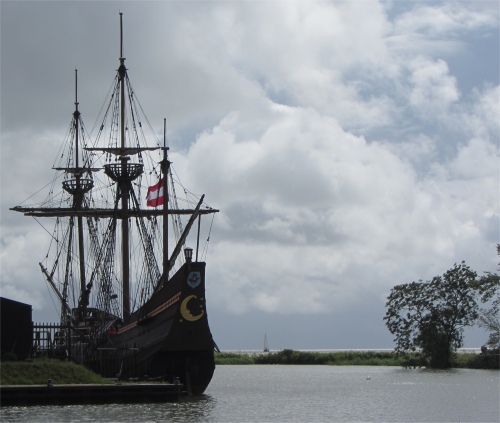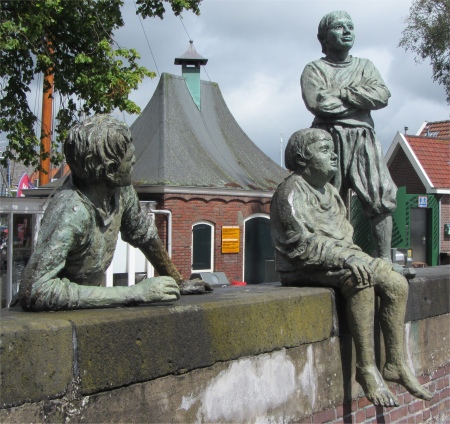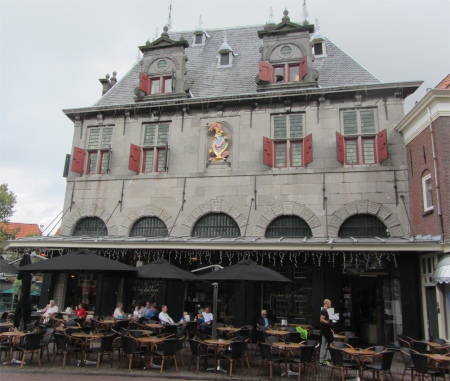
Waag
|
Not only did the original Halve Maen cross the Atlantic and explore the east coast of North America in 1609, but she would later sail to the other side of the globe, where she was destroyed by an English attack on Jakarta in the Dutch East Indies around 1618. The carracks of Portugal, England, Spain as well as the Dutch vlieboots, opened the world to European exploration. In Western terms, they were the ships of the great "Age of Discovery." On the other hand, they were also the plague ships that brought diseases which wiped out an estimated 90% of Native Americans.

West Frisian Museum
|
The day was yet young, so Rex and I braved the weather and started off on a walking tour around Hoorn. Sometime around 1300, farmers and fishermen founded the tiny village of Hoorn, strategically located in a bend on the Westfrisian coast where the Gouw River met the old Zuiderzee, now called Ijsselmeer. By 1357 the place was already of such importance that it was given city-rights by Count Willem V. In 1426 walls were built to protect the city. The walls included four gates, of which only one survives today. As more merchants and bargemen moved into the conurbation, the town slowly grew larger and larger. In 1573 it became the capital of West-Frisia when, after a fierce battle right on its doorstep, a local fleet under the leadership of Cornelis Dirksz had defeated a large Spanish fleet under the command of the Count of Bossu. This was a turning point in the war of independence against Spain.
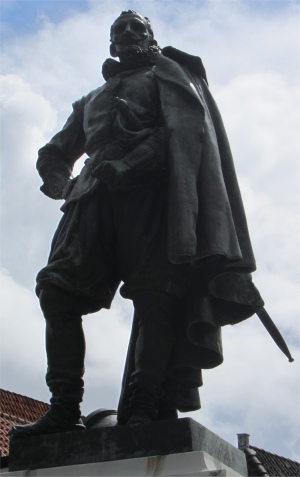
Jan Pieterszoon Coen
|
Ten years later the city minted its own coins, the Westfrisian Rijksdaalder. For Hoorn and its citizens a period of great prosperity had begun and the city now put all its attention to the sea. The harbour was largely extended and business with the Atlantic coast, the Mediterranean, the Baltic States and the Far East bloomed. Hoorn soon became one of the six founding cities of the Vereenigde Oostindische Compagnie (VOC), the world's first multinational company. Ships loaded with spices, tea, coffee, sugar, wheat, silk, cotton, copper and indigo returned from all over the world, as far as South-America and the Arctic Ocean, where whales were hunted for oil. Around 1650, stagnation set in and a century later the city fell into decline. By the end of the French occupation (1795-1813) the population had dropped to a mere 7,500 and the once proud city looked like a disorganised village. But slowly it recovered and today the city booms again with a population of around 70,000. Many of the old buildings have survived and others were restored to their former splendour.

|
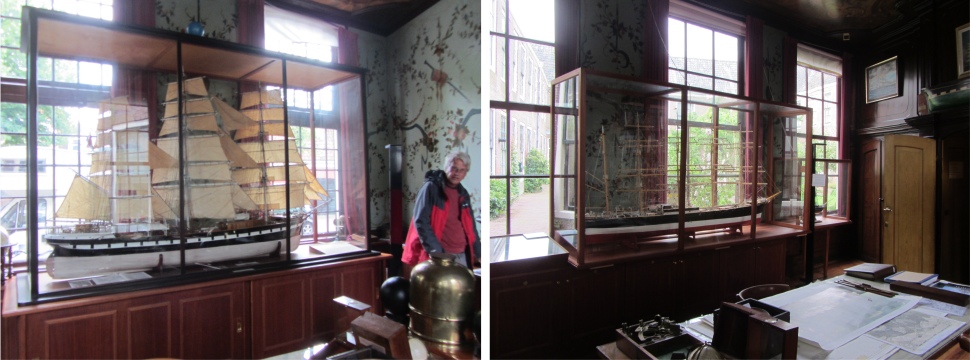
Dutch Cape Horners Foundation Antiquities Building
|
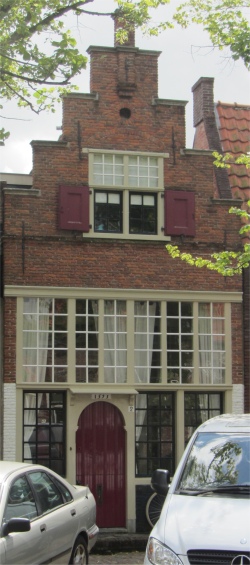
Hoorn's Oldest House
|
Nowadays thousands of tourists from all over the world flock to this historical city, which not only offers the visitor a unique feel of its glorious past, but good shopping and great water sport facilities as well. The latest, and very striking, addition to the town is a brand-new Theatre House right on its waterfront.
Skirting around the marina by walking along the dyke fringing the pretty house fronts along the Achter op Het Zand, we came to the Hoofd, where a turn left brought us up to Hoofdtoren (Main Tower). This late gothic defensive structure, with its white-yellow stone on the seaward side was visible by sailors from far out on the Hoornsche Hop, and it is still a major highlight of the historic Hoorn waterfront. The defensive tower had walls almost 1.5m thick on the seaward side, with loopholes providing a wide field of fire over the sea; it was the main link in the defence against attacks from the sea. It was constructed in 1532, but in 1614 the defensive function of tower was considered no longer necessary, and was then taken over by various civilian institutions. Today it serves as a restaurant.
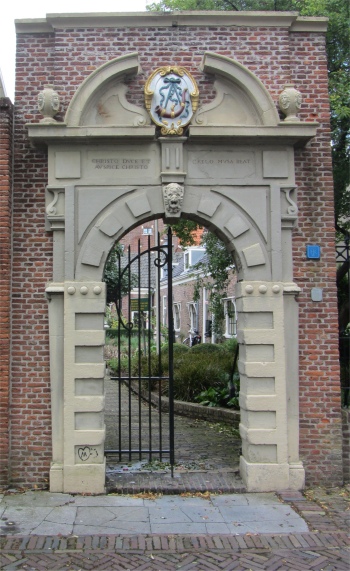
Claes Stapelhofje
|
Just along the quay from the Hoofdtoren, three bronze cabin boys gaze out over the wide waters of what was once the Zuiderzee. They are listening to "the voice of the sea, which entices and intoxicates". They are Hajo, Padde and Rolf, the cabin boys of shipmaster Willem Ijsbrantsz Bontekoe (1587-1657), who found fame with the publication of his ship's log about his improbable journey to Bantam (East Indies) in 1618, which he undertook in the service of the Dutch East India Company during the Golden Age.
Hajo, Padde and Rolf are now more famous than the master of their ship, thanks to one of the greatest storytellers and most prolific writers in Dutch literature, Johan Fabricius, who was inspired by Bontekoe's log to write "
De scheepsjongens van Bontekoe" (Bontekoe's Cabin Boys) in 1924. This superlative, thrilling sea adventure is one of the classics of Dutch children's literature.
It is, above all, their true-to-life nature and their different characters that have ensured the threesome a place in the Dutch collective memory: Hajo is romantic and dreams of adventures in far-off lands. Padde, clumsy, fat and the butt of people's jokes, is 'Hajo's shadow' and reluctantly follows his friend to sea. And Rolf, Bontekoe's nephew and an orphan, is contemplative and calm, and often rescues the others from predicaments.
And they certainly get into plenty of predicaments. Vividly and with a great sense of pace, Fabricius describes how the crew of the
Nieuw-Hoorn is hit by storms, impenetrable fog, Spaniards, becalmed seas and scurvy, the "dreaded enemy". The high point is a true event: an explosion that occurs when, through Padde's fault, a candle flame spreads via a brandy barrel to the gunpowder store. The ship is blasted into a hundred thousand pieces, amidst "hissing and cracking" it disappears into the sea.
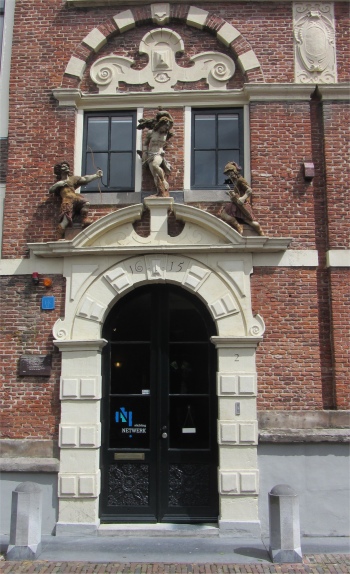
Doelen
|
When the cabin boys are washed ashore on Sumatra, they lose Bontekoe and begin a perilous journey through the interior of Sumatra (the mysterious atmosphere of which is captured perfectly by Fabricius, a native of Indonesia) to Bantam, Java. There, they are reunited with the survivors and with Bontekoe. They arrive back in Hoorn on New Year's Eve 1620, in the spot where they are still standing on the quayside today, thanks to Fabricius' exceptional talent for storytelling.
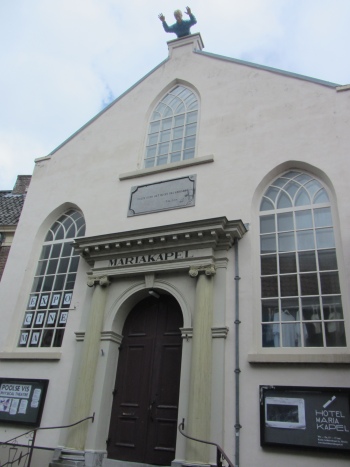
Hotel Mariakapel
|
We made our way via the Korenmarkt to the Roode Steen, which was not as crowded today; probably most tourists had returned to work. On one corner of the square stood the inevitable Waag. From the very beginning of Hoorn, the Roode Steen (Red Stone) was the center of commerce, government and law, and today the Roode Steen is still considered the main square for all kinds of social activities. Here the Waag played a prominent role, especially as regards trade in agricultural products which were imported from the West Frieze hinterland. The weighing was carried out to establish the correct weight, and hence determined the level of payment of an excise duty (tax), which benefited the magistrate of the area. Initially this was Holland van de Graaf. By 1602 the Waag was owned by the city.
Taking pride of place on the square was the imposing building of the West Frisian Museum, a stately monument with its distinctive, richly decorated fašade, housed in the States College since 1881. It contained the original management offices and meeting building of the Executive Committed Councils of West Friesland and Holland's Northern Quarter, which met here several times a year. This marked Hoorn's main square as a place of trade and events that played a key role in the Hoorn existence since 1632.
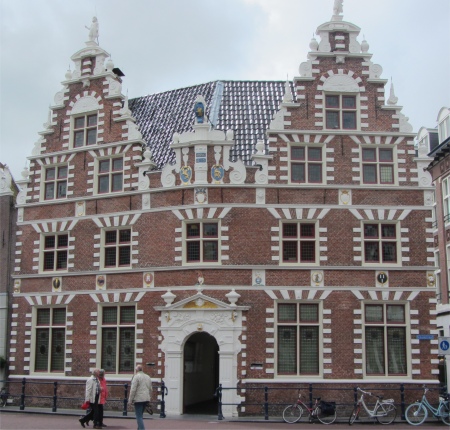
Statenlogement
|
In the square stood a statue of Jan Pieterszoon Coen (1587- 1629), merchant, Director-General and Governor-General of the Dutch East India Company (VOC). He was the architect of the successful trading empire of the VOC in Asia, and founded Batavia, now Jakarta.
Coen was hailed as a forceful and visionary administrator. But he was also criticised for the violent means by which he built up trade monopolies in the East Indies. In 1621 Coen led a punitive expedition against one of the Banda Islands, because the local population was selling nutmeg to the English despite a VOC ban. Thousands of Bandanese lost their lives during the assault, and the survivors were deported to Batavia.
By the end of the 19th century, Coen had acquired the status of a national hero, and was honoured with a statue in his hometown. However, the statue is controversial. According to critics, Coen's violent trade policy in the East Indian archipelago does not deserve to be honoured.
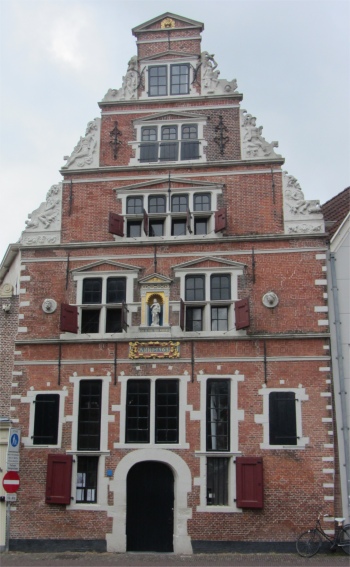
Sint Jans Gasthuis
|
Heading off, we picked up Achterom, where at No. 17 we stumbled across the regent chambers of a former Roman Catholic orphanages. The impressive 18th century antiquities interior is a haven for the Dutch Cape Horners Foundation. There is a library and a collection of antique nautical instruments, including a special star globe. There are also some beautiful ship models, the original Hondius Map is part of the collection, and a wall is lined with original Hoorn wallpaper.
Cape Horn is the southernmost tip of the American continent, stretching far into the stormy sea area known as the Roaring Forties because of the thundering west winds. This cape was on the last route that was still viable for sailing ships carrying cargo, such as grain from Australia and nitrates from Chili to Europe. On these trips, rounding the Horn, was at one and the same time the blackest hour in the already difficult existence of the crew and the high point of their seamanship.
Sailors who have rounded the Horn feel united and in 1937 this led to the founding (in France) of the Amicale Internnational des Capitaines au Long Cours Cap Horniers. After the Second World War, when sail had disappeared, sections of the Amicale were set up in several countries. After a time membership was opened to every one of all ranks who had sailed on cargo ships round the Horn. The society of Dutch Cape Horn Sailors (De Vereeniging van Nederlandse Kaap-Hoornvaarders) was set up in 1959. At the invitation of the municipality, Hoorn was chosen as the registered office as it was from here that the discoverers of the Horn, Le Maire and Schouten, originated.
In 1605, Isaac Le Maire, Jacob's father, was forced to leave the VOC after a dispute and for the next decade tried to break the company's monopoly on the trade to the East Indies. By 1615 Isaac had established a new company, the Australian Company, with the goal to find a new route to the Pacific and the Spice Islands, thereby evading the restrictions of the VOC, which controlled the Strait of Magellan. He contributed to the outfitting of two ships, the
Eendracht and
Hoorn, and put his son Jacob in charge of trading during the expedition. The experienced ship master, Willem Schouten, was captain of the
Eendrachtt and a participant of the enterprise in equal shares with Isaac Le Maire.
On 29th January 1616, Jacob Le Maire and Willem Cornelisz Schouten discovered the southernmost tip of South-America and named this point Cape Hoorn, after the name of their hometown. Sailing through this unknown open water between Atlantic Ocean and the Pacific Ocean, they established the basis for greater expansion of world trade with sailing vessels, than passing through the Strait of Magellan. The Dutch charted Strait Le Maire and other coastlines in this area and around Cape Horn and then continued to the East Indies.
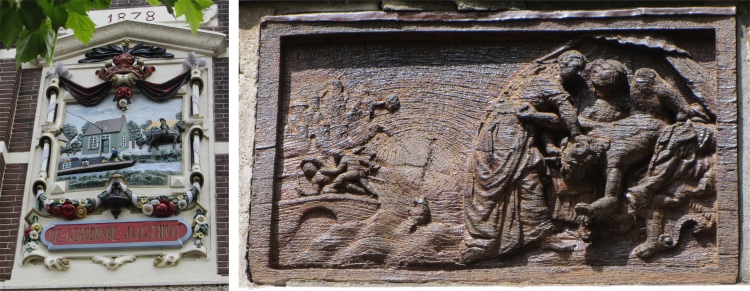
Wall Plaques
|
The Society flourished, with a membership of almost 100 still living Cape Horn sailors, and it had its own magazine in which member's experiences were published. The last reunion was held in 1979 and in 1985 the dying society became a foundation which aimed at keeping the memories of the great days of sail, particularly round Cape Horn, alive.
The Dutch Cape Horners Foundation now has almost 500 contributors or "participants", most of whom are interested in the history of seamanship in the wider sense. None have actually sailed around the Horn on cargo carrying sailing ships. The last member who actually did so, Captain Pieter G. van der Hoek, died on the 13th June 2008 at the age of 92. On the other hand, the number of members who have sailed round the Horn in charter ships and yachts during the last three decades is growing. Hoorn awards to the skippers of these ships a special trophy, whilst the Foundation awards the crews with a medallion.
Leaving the delightful building, we headed to the nearby water front and walked up to the Schouwburg, the brand-new Theatre House, where we enjoyed a coffee before moving on. We worked our way around to the Munnickenveld, named after the former meadow that was in use by the monks who ran the St. Pietershof. The house at No. 2 is the oldest surviving house in the city. It dates from 1593 and was renovated completely after a fire in 1945.
The nearby Claes Stapelhofje courtyard, founded in 1682 by Claes Stapel and two other Hoorn notables, Jan Jansz Koekebacker and Pieter Bos, offered accommodation to widows and older women with little or no means of living.
In No. 2 Achterstraat stood the building De Doelen, where from 1615, Hoorn St. Joris and St. Sebastian Militiamen gathered for marksmen training, meetings, food and festivities.
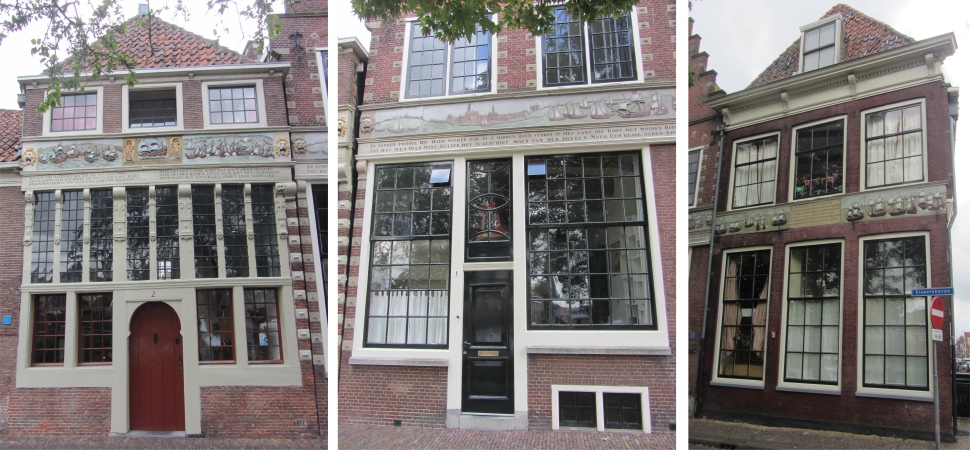
Houses on Slapershaven
|
Continuing down into Korte Achterstraat, we discovered the Hotel Maria Kapel, with its peculiar figure lying horizontally above the gable. It is located in an early 16th century chapel, surrounded by a semi-private courtyard. This beautifully, tranquil and spacious working environment offers the artists-in-residence a unique space for reflection, experimentation and production, as well as exhibition space and a cinema for contemporary visual art in the city centre.
We stopped for a while to admire a beautiful building, trying to make out what it had been, when an elderly lady came up to us and explained that it had once been a courthouse, then it spent a while as a monastery, and now it contained flats for old people over 55 (crumbs, I must be ancient), where each flat consisted of two rooms. "You speak good English," I complimented her. "I was not taught English, and I have never been to England, though me and my cousin would like to visit London at Christmas. My two daughters live in Australia, one in Sydney and the other in Canberra. I also watch the BBC a lot on T.V.," she added. For many years the Dutch have received T.V. broadcasts from many countries. She was amazed we couldn't even get Irish T.V., never mind Dutch T.V. "When I was a child, I tried to say English words that began with "th", and to pronounce that you need to put your tongue out a little. I would get a slap for putting my tongue out. Now I can pronounce "th" properly, but I still get an anxious feeling when I pronounce it," she told us.

Barge Struggling to Enter Hoorn
|
The lady went about her business, while we carried on our hike, trying to work out how many of these stunning old buildings can claim to be the oldest.
Dropping down to Nieuwstraat, we passed the Statenlogement (State Lodgings) with its beautiful double step-gable from the period of the Dutch Renaissance (1613).
Passing down into Kerkstraat, we came across the Sint Jans Gasthuis (1563), where the grooved stones on both sides of the door were said to have healing properties. This was originally a hospital and later became a trading place for eggs and butter. In the early Middle Ages, monasteries were often the only place that provided shelter for pilgrims and travellers. They also took care of the sick. Monks saw this concern as an obligation from the Christian charity. The name "guest house" was coined in the 16th and 17th centuries. This Hoorn hospital is important not only because it is an example of the most common spatial structure of the medieval hospitals, but it provides Hoorn with the best preserved example, and from a national point of view, one of the rare examples of an important building in the transitional period from Gothic architecture to the early Renaissance.
Making our way across to the Slapershaven, where we could not help but marvel at the artistic, maritime themed friezes on the fronts of a group of houses. We took a turn off to visit a couple of other marinas in the city, the Binnenhaven and Vluchthaven, indeed half the city seemed to be full of boats. With the sky almost black, we headed down the Oude Doelenkade, where we had to rapidly seek shelter when a sudden wet squall struck. The pontoons running along Hoofd were awash with rafted up training boats, crammed with teenagers either eagerly pulling on ropes or glued to their mobile phones. In the distance a barge under sail was fighting through a Force 5, spray flying over the bows. Even these large boats rocked out in the teeth of this wind.
Back on
Duonita, it was clear the wind had changed direction, and the bow rope was chaffing. Rex was concerned about how quick this chaffing had occurred, and to ease his mind he doubled up the bow ropes; it could turn out particularly nasty if the current bow rope failed.
In the early evening I spotted folk dashing to the rescue boat moored 20m away from us. This was currently sitting up in the air, and was launched by releasing air from a pair of flotation tanks that kept it air bound, and it gracefully returned back to the water. Soon it was bouncing across the Hoornsche Hop, and then it was gone around a headland. An onshore assistant told me a boat was on the dyke. Two in one day - sad occasions.
The wind whistled around Hoorn throughout the evening, chucking down the occasional burst of rain. Seems to be a pattern developing here.
